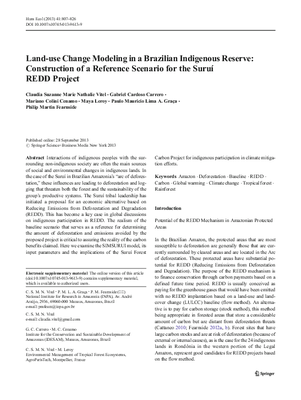Land-use Change Modeling in a Brazilian Indigenous Reserve: Construction of a Reference Scenario for the Suruí REDD Project
Abstract: Interactions of indigenous peoples with the surrounding non-indigenous society are often the main sources of social and environmental changes in indigenous lands. In the case of the Suruí in Brazilian Amazonia’s “arc of deforestation,” these influences are leading to deforestation and logging that threaten both the forest and the sustainability of the group’s productive systems. The Suruí tribal leadership has initiated a proposal for an economic alternative based on Reducing Emissions from Deforestation and Degradation (REDD). This has become a key case in global discussions on indigenous participation in REDD. The realism of the baseline scenario that serves as a reference for determining the amount of deforestation and emissions avoided by the proposed project is critical to assuring the reality of the carbon benefits claimed. Here we examine the SIMSURUI model, its input parameters and the implications of the Suruí Forest Carbon Project for indigenous participation in climate mitigation efforts.
https://biodiversitylinks.org/projects/completed-projects/translinks/peer-reviewed-journal-articles/land-use-change-modeling-in-a-brazilian-indigenous-reserve-construction-of-a-reference-scenario-for-the-surui-redd-project/view
https://biodiversitylinks.org/projects/completed-projects/translinks/peer-reviewed-journal-articles/land-use-change-modeling-in-a-brazilian-indigenous-reserve-construction-of-a-reference-scenario-for-the-surui-redd-project/@@download/image/image.png
File
Land-use Change Modeling in a Brazilian Indigenous Reserve: Construction of a Reference Scenario for the Suruí REDD Project
Author(s):
Claudia Suzanne Marie Nathalie Vitel
,
Gabriel Cardoso Carrero
,
Mariano Colini Cenamo
,
Maya Leroy
,
Paulo Mauricio Lima A. Graça
,
Philip Martin Fearnside
Publication Date: 2013
Location: Rondonia/Mato Grosso, Brazil
DOWNLOAD FILE
Abstract: Interactions of indigenous peoples with the surrounding non-indigenous society are often the main sources of social and environmental changes in indigenous lands. In the case of the Suruí in Brazilian Amazonia’s “arc of deforestation,” these influences are leading to deforestation and logging that threaten both the forest and the sustainability of the group’s productive systems. The Suruí tribal leadership has initiated a proposal for an economic alternative based on Reducing Emissions from Deforestation and Degradation (REDD). This has become a key case in global discussions on indigenous participation in REDD. The realism of the baseline scenario that serves as a reference for determining the amount of deforestation and emissions avoided by the proposed project is critical to assuring the reality of the carbon benefits claimed. Here we examine the SIMSURUI model, its input parameters and the implications of the Suruí Forest Carbon Project for indigenous participation in climate mitigation efforts.



